Bhubaneswar - Dhenkanal - Sonepur - Sambalpur - Bargarh - Pipli - Puri - Konarak - Bhubaneswar
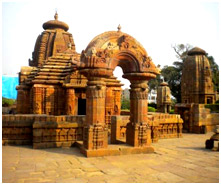 Day 1: Arrive Bhubaneswar
Day 1: Arrive Bhubaneswar
Welcome to Bhubaneswar – The Temple City of India
Meet and assist on arrival and transfer to Hotel.
Being the seat of Tribhubaneswar or 'Lord Lingaraj ', Bhubaneswar is an important Hindu pilgrimage centre. Hundreds of temples dot the landscape of the Old Town, which once boasted of more than 2000 temples. Visit The Mukteshwar Temple which is one of the most prominent temples of Bhubaneswar and has been constructed in the style that is quite similar to the one used in the Kalinga School of Temple Architecture. It has an elegant and superb arch gate. It appears as if it has been finished by jewelers and not sculptors. Such is the delicacy and intricacies of its details. Overnight at Hotel-Bhubaneswar.
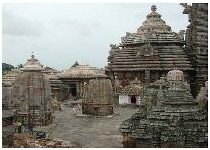 Day 2: Bhubaneswar – Temples and Caves
Day 2: Bhubaneswar – Temples and Caves
Breakfast at Hotel.
Visit the Temple City of Bhubaneswar.
Among the finest of its 600 temples is the Lingaraj Temple of Shiva built in the 11th century, it is also the biggest in Bhubaneswar. The temple is dedicated to Lord Shiva, also known as ‘Lingaraj’. It is adorned with beautiful sculptures, which have been carved on the spire.  Bindusagar Lake lying to the north of the Lingaraja Temple, is one of the popular tourist attractions of Bhubaneswar. Lingaraj Temple (Non Hindu are not allowed inside the temple. To be viewed from a platform outside) . Mukteshwar Temple, is one of the most prominent temples of Bhubaneswar and has been constructed in the style that is quite similar to the one used in the Kalinga School of Temple Architecture.
Bindusagar Lake lying to the north of the Lingaraja Temple, is one of the popular tourist attractions of Bhubaneswar. Lingaraj Temple (Non Hindu are not allowed inside the temple. To be viewed from a platform outside) . Mukteshwar Temple, is one of the most prominent temples of Bhubaneswar and has been constructed in the style that is quite similar to the one used in the Kalinga School of Temple Architecture.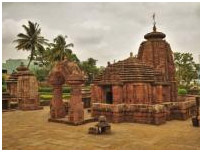 Rajarani Temple is one of the most renowned temples in Bhubaneswar, the capital city of Orissa. It is made from the wonderful red and gold sandstone, which is locally known as Rajarani and this is what gives the temple its name of ‘Raja Rani’.
Rajarani Temple is one of the most renowned temples in Bhubaneswar, the capital city of Orissa. It is made from the wonderful red and gold sandstone, which is locally known as Rajarani and this is what gives the temple its name of ‘Raja Rani’.
Afternoon visit the ancient caves of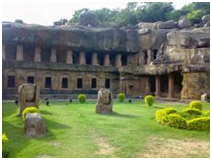 Khandagiri and Udaygiri which were carved and tunneled, to create this multi-storied ancient apartment residence for Jain monks. They were the work of the first known Orissan ruler, King Kharavela, and probably begun in the first century BC. Kharavela was a king of the Mahameghavahana dynasty, who is known for expansion of the Kalinga empire and his installation of public improvements, such as canal systems. His queen was evidently quite a patron of the arts, and probably had much to do with the impressive sculptural decoration of the caves.
Khandagiri and Udaygiri which were carved and tunneled, to create this multi-storied ancient apartment residence for Jain monks. They were the work of the first known Orissan ruler, King Kharavela, and probably begun in the first century BC. Kharavela was a king of the Mahameghavahana dynasty, who is known for expansion of the Kalinga empire and his installation of public improvements, such as canal systems. His queen was evidently quite a patron of the arts, and probably had much to do with the impressive sculptural decoration of the caves.
Overnight at Hotel- Bhubaneswar
After breakfast leave for Dhenkanal enroute visit and interaction with the local community of traditional weaving and dokra tribal crafts village at Nuapatna and Sadeibarani
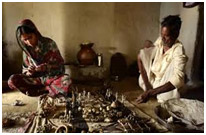 Sadeibarni - Dokra crafts - The Dhokra casting, a variety of metal casting is essentially a folk craft and is limited to a few pockets of Orissa. In Sadeiberni, in Dhenkanal district, it is being practiced by an aboriginal caste called sithulias. While the lost wax process is followed, the raw materials used are not pure brass but contain miscellaneous scraps of other metals which give it an antique look. Its motifs are mostly drawn from folk culture.
Sadeibarni - Dokra crafts - The Dhokra casting, a variety of metal casting is essentially a folk craft and is limited to a few pockets of Orissa. In Sadeiberni, in Dhenkanal district, it is being practiced by an aboriginal caste called sithulias. While the lost wax process is followed, the raw materials used are not pure brass but contain miscellaneous scraps of other metals which give it an antique look. Its motifs are mostly drawn from folk culture.
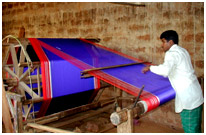 Nuapatna - Weaving village - This village with many co-operatives of weavers, where centuries of tradition woven into fabric. The weavers of this village are a class by themselves. The TIE & DYE patterns popularly known as ‘IKAT’ is a unique mechanism of texturing. One can watch all the steps of Ikat Bandha. As per the tradition they weave in silk.
Nuapatna - Weaving village - This village with many co-operatives of weavers, where centuries of tradition woven into fabric. The weavers of this village are a class by themselves. The TIE & DYE patterns popularly known as ‘IKAT’ is a unique mechanism of texturing. One can watch all the steps of Ikat Bandha. As per the tradition they weave in silk.
After visit proceed to Dhenkanal.
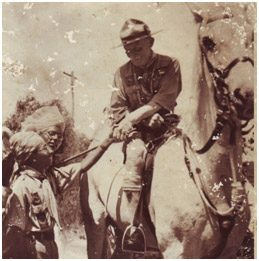 Dhenkanal which is the gateway to one of the most ancient forest covers of Orissa, which shelters the elephants, tigers and numerous species of birds and beasts. The broad plains of the river Bramhani were the dwelling place of early homo-sapiens who lived on the berries and wild fruits before the advent of rice on these heavily watered expanses. The surrounding Sal forests come ablaze with the changing seasons making this district headquarters town focal point of trips to beautiful interiors.Dhenkanal District is situated on the Cuttack Sambalpur Road( NH 55) and the Cuttack Sambalpur S.E. Railway line. It is bounded by the Keonjhar District in north, Cuttack district in south, Jajpur in the east and Angul in the west.It is commonly believed that it owes, its name to a Savara chief called Dhenka who formerly ruled over in this tract.
Dhenkanal which is the gateway to one of the most ancient forest covers of Orissa, which shelters the elephants, tigers and numerous species of birds and beasts. The broad plains of the river Bramhani were the dwelling place of early homo-sapiens who lived on the berries and wild fruits before the advent of rice on these heavily watered expanses. The surrounding Sal forests come ablaze with the changing seasons making this district headquarters town focal point of trips to beautiful interiors.Dhenkanal District is situated on the Cuttack Sambalpur Road( NH 55) and the Cuttack Sambalpur S.E. Railway line. It is bounded by the Keonjhar District in north, Cuttack district in south, Jajpur in the east and Angul in the west.It is commonly believed that it owes, its name to a Savara chief called Dhenka who formerly ruled over in this tract.
Arrive and Check into Dhenkanal Palace - A heritage home Stay Experience, but not be taken as deluxe or luxury standard as in Rajasthan Palaces.
Explore the Palace surroundings and interact with the Royal family-subject to their presence. Overnight at Dhenkanal – Dhenkanal Palace – Heritage Home Stay
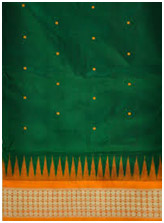 Day 4: Dhenkanal – Sonepur - Sambalpur – 260 kms / 5.5hrs
Day 4: Dhenkanal – Sonepur - Sambalpur – 260 kms / 5.5hrs
After breakfast we leave for Sambalpur enroute visiting Sonepur Ikat weaving village.
Bomkai Saree or Sonepuri Saree is a handloom saree primarily produced by the Bhulia community. Shilpaguru Padmashree Chaturbhuj Meher is a genius in tie and Dye handloom weaving art who has immensely contributed towards the revival and development of handloom textile to an unimaginable artistic height and also for improvement of the socioeconomic condition of the weavers’ community at large. He was born into the weaving community of Sonepur and started making saris at the age of 12. Interact with the weavers in this village and get an insight into their techniques .
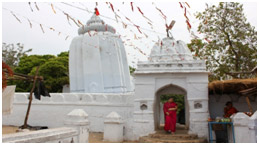
Drive to Sambalpur enroute visiting the HumaTemple - This village contains the Leaning temple dedicated to Lord Siva The surprising thing is, the main temple tilted to one direction and other small temples tilted to some other direction. And within the temple complex i.e. within the boundaries of temple, everything found to be in tilted condition including the boundaries. The worship of Siva is said to have been initiated by a milkman(Gauda), who daily crossed the Mahanadi to a place on the bank where the underlying rock croped out. Here he daily offered his dole of milk, which was at once drunk up by the rock, and this miraculous circumstance led to enquiries, which ended in the construction of the present temple. The special type of fish found here are called as 'Kudo' fish. They are said to be so tame that they will eat sweets and other foods from the hands of those who bathe close to the temple. During auspicious days they are called by their names and given the 'prasad' of the God. Here nobody tries to catch them as they are believed to be the assets of the God.
Overnight at Hotel-Sambalpur
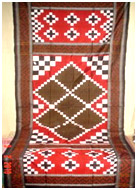 Day 5: Sambalpur – Bargarh – Sambalpur –50 kms / 45mins each way
Day 5: Sambalpur – Bargarh – Sambalpur –50 kms / 45mins each way
After breakfast at Hotel we leave for an excursion to Bargarh to explore the weaving legacy of this place and its famous Sambalpuri Saree.
Sambalpuri sarees are some of the most beautiful saris in India. These saris are incomparable. A conventional handloom silk sari, the Sambalpuri is a traditional handwoven Ikkat weave from the state of Orissa. Famous for its Kathan border & pallu, the Sambalpuri till date is made according to ancient norms.
What’s unique about this weave is that, once the fibers have been dyed, it can never be bleached into another color, in fact the cloth may deteriorate with time, but its color never fades.Varieties of the Sambalpuri saris include Sonepuri, Pasapali, Bomkai, Barpali, Bapta saris have substantial demand. Most of them have been named after the places of their origin, and are popularly known as Pata . The Shankh (shell), Phool (flower) and chakra (wheel) are motifs that are distinct to the Sambalpuri Saree.
Former Indian Prime Minister Indira Gandhi became a sort of 'brand ambassador' of the Sambalpuri sari - it was her favourite attire!
Overnight at Hotel-Sambalpur
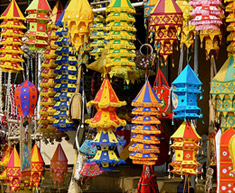 Day 6: Sambalpur –Pipli - Puri – 340 kms / 6.5hrs
Day 6: Sambalpur –Pipli - Puri – 340 kms / 6.5hrs
After breakfast at Hotel we leave for Puri enroute visiting Pipli, a unique village where the entire community is involved in appliqué work. Pipli – It’sa centre for appliqué work, which depicts the essence of Oriya culture. It is also known for colorful and original awnings, canopies, garden and beach umbrellas, shoulder and handbags etc. The cocktail effect of the colors is certainly a feast for the eyes. Pipli, Odisha's appliqué capital, announces itself with loud colourful splashes of bright colour in the shop fronts.
Proceed to Puri. All hotels in Puri have check-in/check-out at 08:00 hrs
For centuries now, the beach at Puri has been the venue of countless pilgrims taking the traditional purifying dip. However, for decades now, both Indian and foreign beach lovers have made it their special haunt. The fine golden sands of Puri beach and the roar of the breakers rolling in from the Bay of Bengal have fascinated visitors throughout the ages. As it is with all the beaches of Odisha, overcrowding is never a problem and the sight of holiday-makers having entire stretch of the beach to them is not uncommon. The local fishermen, with their catamarans and wide brimmed cane hats are welcomed by tourists.
During the early days of imperial rule in India, the British received some of their first impressions of India's spiritual culture via their encounters in the holy city of Jagannath Puri — encounters which plunged the British deep into severe cultural shock.
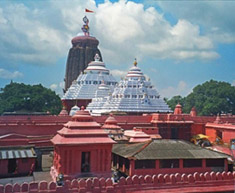 Later in the afternoon visit the Jagannath Temple at Puri which is one of the most sacred pilgrimage spots in India. This 12th century temple is dedicated to Lord Jagannath –“The Lord of the Universe”. The wooden figures of the three deities, Jagannath, Balabhadra and Subhadra stand in the sanctorium garlanded and decorated by the high priests. The extraordinary form that Jagannath takes, according to the legend, is the unfinished work of the craftsman god Viswakarma, who in anger left this portrayal of Lord Vishnu incomplete. This majestic temple and its chronicles allure devotees from all over the world. The wide Bada Danda, the road which leads up to the majestic temple, provides a view of the grandness of scale and proportion that typifies Puri. This is also the path to Nirvana, where the chariots of the much-loved divine siblings, Jagannath, Subhadra and Balabhadra, roll down in the famous annual Rath Yatra, which inspires awe and draws tumultuous crowds. In Puri, everything has to be big. The main road is called Bada Danda, or Grand Road; the sea is Mahodadhi, or the widest ocean; the bhog is called Mahaprasad, or the great prasad.
Later in the afternoon visit the Jagannath Temple at Puri which is one of the most sacred pilgrimage spots in India. This 12th century temple is dedicated to Lord Jagannath –“The Lord of the Universe”. The wooden figures of the three deities, Jagannath, Balabhadra and Subhadra stand in the sanctorium garlanded and decorated by the high priests. The extraordinary form that Jagannath takes, according to the legend, is the unfinished work of the craftsman god Viswakarma, who in anger left this portrayal of Lord Vishnu incomplete. This majestic temple and its chronicles allure devotees from all over the world. The wide Bada Danda, the road which leads up to the majestic temple, provides a view of the grandness of scale and proportion that typifies Puri. This is also the path to Nirvana, where the chariots of the much-loved divine siblings, Jagannath, Subhadra and Balabhadra, roll down in the famous annual Rath Yatra, which inspires awe and draws tumultuous crowds. In Puri, everything has to be big. The main road is called Bada Danda, or Grand Road; the sea is Mahodadhi, or the widest ocean; the bhog is called Mahaprasad, or the great prasad.
(Non Hindus are not allowed inside the Jagannath temple and to be viewed from Raghunathan library platform. Sunday and all local Odisha Government holiday this platform is closed but one can walk along the holy streets and interact with the local community.)
Overnight at Hotel- Puri.
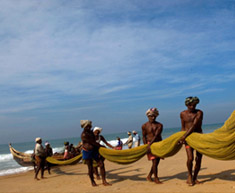
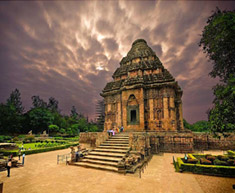 Day 7: Puri-Konarak-Puri–110 kms/2 hrs
Day 7: Puri-Konarak-Puri–110 kms/2 hrs
After breakfast proceed for an excursion to Konark Sun Temple.
Konark - The third link in the Odishan Golden Triangle, Konark is the site of one of the most spectacular examples of religious architecture in the world. The Sun Temple at Konark conceived as a massive chariot hauling the Sun God across the heavens by the might of seven splendidly carved horses, standing aloft on 24 chariot wheels-intricately carved - symbolizing the march of time, lies in solitary splendor surrounded by drifting sand three kilometres from the sea, but originally it was reported to be closer for which it was used as a navigational point by European sailors, who referred to it as the 'Black Pagoda'. This 13th century architectural marvel is one of the most magnificent monuments of the World and also a UNESCO World Heritage site. Nobel Laureate & Poet Rabindranath Tagore said, 'here the language of stone surpasses the language of man'. It is true that the experience of Konark is impossible to translate into words.
Also visit the local Fishermans village and interact with the local community.
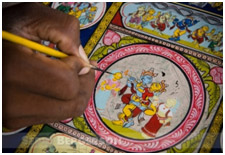 Afternoon visit Raghurajpur – A Heritage crafts village – The big attraction at Raghurajpur is that the whole village community is involved in making some kind of handicraft. Many have even won national awards for their work. There are just over 100 households and 300 artisans in the village. You can wander around, check out the beautiful painted murals on the houses, chat to the friendly artisans and see them in action -- and of course shop! Pattachitra traditional cloth paintings are a specialty in the village, but the artisans make a wide variety of items including palm leaf engravings, stone carvings, wood carvings, and wooden toys. You will also have the opportunity to witness crafts demonstration by the families.
Afternoon visit Raghurajpur – A Heritage crafts village – The big attraction at Raghurajpur is that the whole village community is involved in making some kind of handicraft. Many have even won national awards for their work. There are just over 100 households and 300 artisans in the village. You can wander around, check out the beautiful painted murals on the houses, chat to the friendly artisans and see them in action -- and of course shop! Pattachitra traditional cloth paintings are a specialty in the village, but the artisans make a wide variety of items including palm leaf engravings, stone carvings, wood carvings, and wooden toys. You will also have the opportunity to witness crafts demonstration by the families.
Overnight at Hotel- Puri.
Today after breakfast proceed to Bhubaneswar airport for departure with lots of memories to cherish for a life time!
This is the end of the Trip!
Happy Memories!
